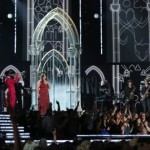The Feedback Loop is a weekly column by Luke Larsen that seeks to find God amidst the newest trends in both mainstream music and independent music.
Stars is a band who has practically built its decorated fourteen year career on melancholy and heartbreak. Co-singers Torquil Campbell and Amy Millan like to let their melodies sink into the lower half of their vocal ranges, trading lines like a pair of star-crossed teenage lovers and letting their catchy indie-pop instrumentals do the rest. Stars’ songs are emotionally heavy — and sappy, yes — but drenched in late-night emotions and cinematic moments.
You’ll still find your fair share of rom-com scenes on the band’s newest album, The North. However, this time around, the Canadian indie-pop band seems to have found reasons for their music with a surprising amount of upbeat energy and optimism. In contrast to their previous records, Millan calls The North “playful, joyful and hopeful.” For a different band, you might end with something a little hard to stomach. But for Stars the outcome is a group of songs that compellingly embraces themes of contradiction.
Despair and hope. Light and dark. Warm and cold. Some of the best songs on the album such as “Hold On When You Get Love And Let Go When You Give It” and “A Song Is A Weapon”, comfortably fit this dichotomy.
The album opens with the single, “The Theory of Relativism,” a song that will fit perfectly next to songs from In Our Bedroom After The Room and The Five Ghosts in a Stars Greatest Hits compilation someday. Frosty synths and a mellow dance beat fill the background as Campbell’s confident vocals take center stage. He strikes a particularly interesting thematic perspective in the song — one that’s set in a fictional future with references to a “cybergirl,” “snow in Hawaii,” and “building homes in the new third world.” But the song is also doused in a nostalgia for the past: “Back in lame grade 10 I was a total devastator, baby/Down in the schoolyard they all fell to their knees/But it can’t be 93, sadly ‘cuz I wish it could forever/You call it luck I call it tragedy.”
The cover of The North is a photograph of Habitat 67, an experimental piece of residential architecture — a re-imagining of urban communities and dense living situations. Habitat 67 looks remarkably futuristic to the common eye, its 354 cube-like concrete apartments asymmetrically stacked like Lego blocks. It looks forward thinking and progressive, but Habitat 67 isn’t exactly a new building. It was designed and built back in 1967.
From an interview with The Montreal Gazette, the band describes the photograph on the cover of The North explaining, “The album art comes from a time when Canada was so young and futuristic and had all these amazing ideas that just aren’t around anymore. That time could manifest itself in the architecture.” However, the cover seems to be saying as much about the band as it is about Canada. It’s as much about looking forward as it is about looking back.
Stars is a band that sees the great hope and potential that lays dormant in life. The North celebrates the highs of love and life with an uncanny vigor, but also wrestles with deepest of despair that lurks behind each and every corner in life. A younger Torquil Campbell may have been quick to jump to one conclusion or the other, but in The North he finds warmth even in the dead of winter.












